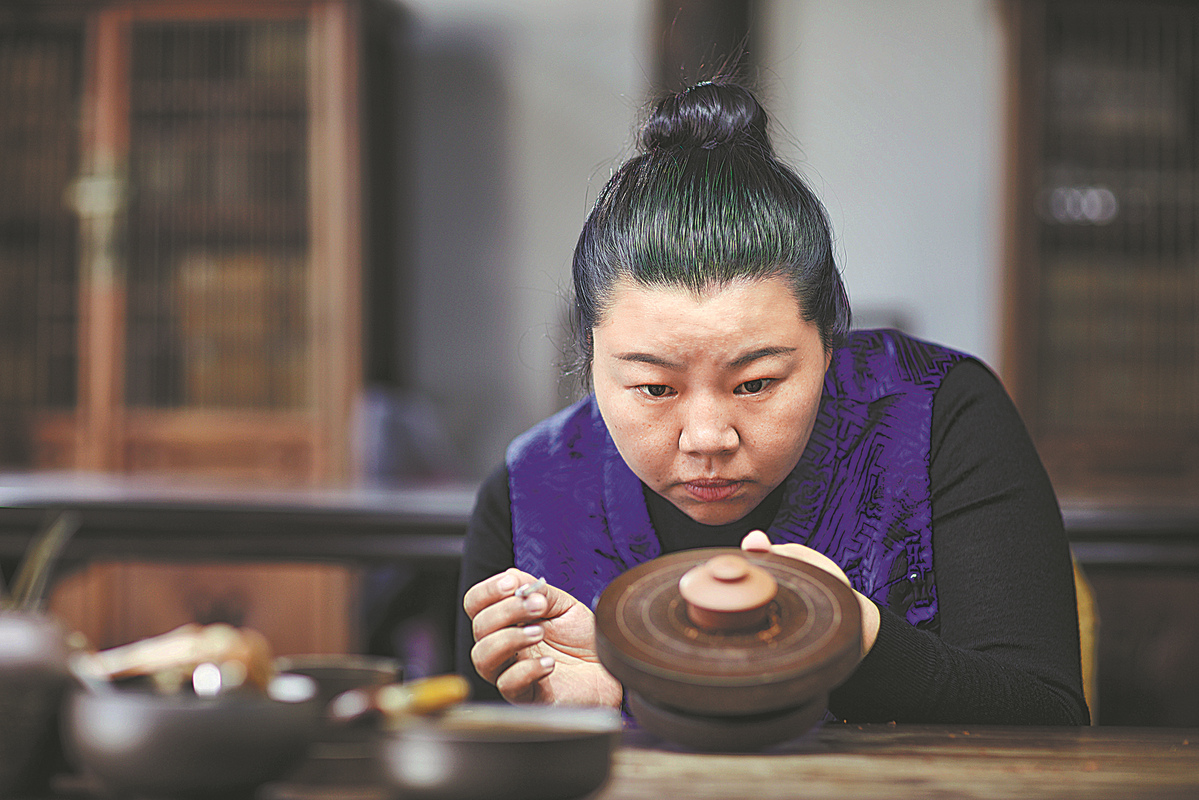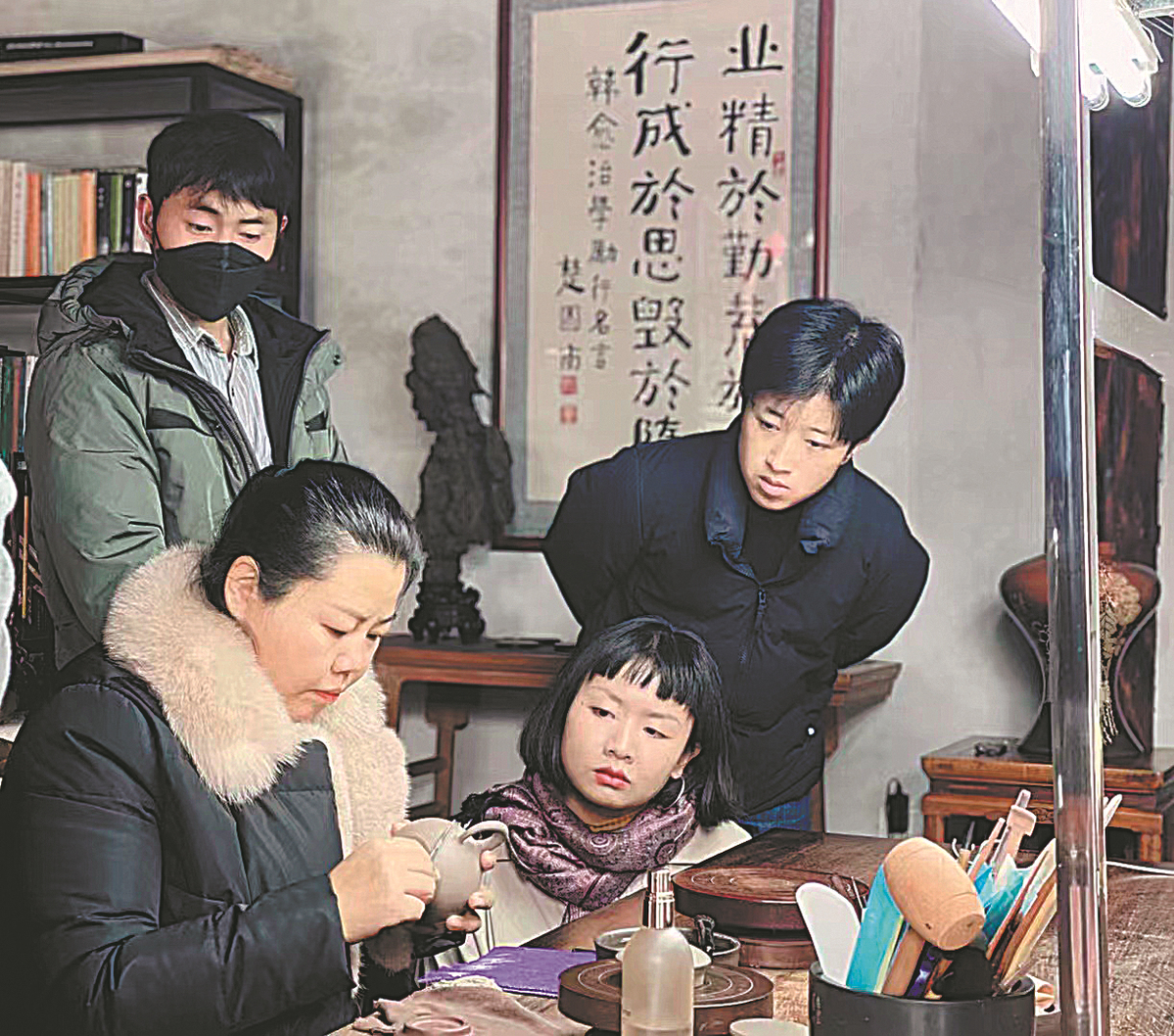Ceramist to promote heritage projects

Tian Jing works at her purple pottery learning center in Jianshui, Yunnan province. CHINA DAILY
Tian Jing can't wait to share her ideas about protecting intangible culture heritage and inheritance during the upcoming two sessions, the annual gatherings of China's national legislative and top political advisory bodies.
The 45-year-old was born in Jianshui county, Southwest China's Yunnan province, and is a member of the National Committee of the Chinese People's Political Consultative Conference.
Tian said she would suggest increasing joint efforts between governments, schools and companies linked to culture to strengthen intangible culture heritage training at vocational schools in areas inhabited by ethnic minority groups.
She called upon the parties concerned to take into account associated needs such as schools setting up relevant academic majors and offering employment support.
Theory and practice should also be organically integrated during teaching, she added. "Since the 18th CPC National Congress, China's intangible cultural heritage protection and inheritance work has achieved tangible results," Tian said.
"A large number of intangible cultural heritage projects have been protected, and conditions have been significantly improved for intangible cultural heritage inheritors to carry on their traditions."
At last year's two sessions, Tian proposed increasing the number of intangible cultural heritage teachers at medium-level vocational schools in areas inhabited by ethnic minority groups and building national intangible cultural heritage digital museums.
"Both proposals have advanced," she said.
Since a guideline was released in August by the general offices of the Communist Party of China Central Committee and the State Council, China's Cabinet, efforts have been stepped up to protect, promote and popularize intangible cultural heritage, including through government funds for preservation, reduced interest on loans and tax incentives.
"It was a substantial protective policy, and many vocational schools now offer classes in intangible cultural heritage skills," Tian said.
She was named a provincial inheritor of Jianshui's national intangible culture heritage of "purple pottery firing" in 2014. Jianshui's purple pottery, which flourished during the Qing Dynasty (1644-1911), is made from the county's "five-color" clay, which consists of red, yellow, purple, white and green clays colored by various minerals. Finished pieces are hand-painted and coated in an unglazed polish.

Apprentices watch Tian making a teapot at the center. CHINA DAILY
Jianshui pottery is also often decorated with Chinese calligraphy and painting, adding to its cultural worth.
Tian's love of pottery was born of her love of tea, and when she was 17, she decided she wanted to make her own tea set. She first trained with local potters to learn basic skills, and each had their own area of expertise. She said that some were good at making clay, some at fashioning clay models, and others excelled at firing.
Tian realized that few potters at the time were experts in every skill, and that creating a fine piece of purple pottery required a lot of work and patience.
"The biggest difficulty for me was systematically acquiring the knowledge I needed to make traditional Jianshui purple pottery," Tian said.
Back then, purple pottery was mostly made in family workshops, and mainly in the form of cooking pots and vases. There were only a few types of teapot. Tian felt that it was a pity the workshops weren't making teapots of more artistic value.
With her family's support, Tian got a place at Jingdezhen Ceramic University in 2012, where she spent five years studying porcelain modeling, clay making, decorating, sculpting and firing.
She gradually developed her own style of making teapots. She went on to establish a purple pottery learning center in 2018.
Under her influence, many of Tian's apprentices have gone from merely knowing purple pottery to loving it, and their hometown.
Most of the apprentices she has recruited over the years have been young villagers for whom the direct benefit of learning the craft is the ability to make a living.
Lyu Baojing has been studying purple pottery for four years.
"I started by drawing patterns and then created designs on my own, and whenever I was confused, Tian always answered my questions with patience," said the 28-year-old, who used to take odd jobs outside Jianshui.
Lyu was finally able to produce marketable items after about 18 months of practice.
"Learning purple pottery has raised my monthly income from about 3,000 yuan ($475) to more than 10,000 yuan," Lyu said. "At the same time, I feel reborn and have found direction in life."
Tian said most of her apprentices have seen their annual incomes increase from 10,000 yuan to 60,000 yuan over the past decade.
To date, she has trained 500 young women, who are now able to work flexibly from home. Many apprentices have also gone on to set up their own workshops and have brought more people into the craft.
Photos
Related Stories
- CPPCC members propose to boost snow &ice industry
- China's economic recovery helps stabilize employment: spokesperson
- Hong Kong's new electoral system guarantees people's democratic rights: spokesperson
- China's anti-pandemic approach helps stabilize global industrial, supply chains: spokesperson
- China's 2022 foreign trade to run in reasonable range: spokesperson
Copyright © 2022 People's Daily Online. All Rights Reserved.










